 |
 |
|
 |
Road crews take on season’s heaviest snowstorm |
 |
 |
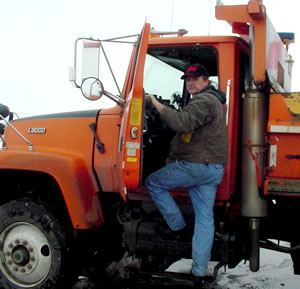 |
|
Galen Henjum, a transportation generalist at Willmar, begins another round of plowing his route on Hwy 12 west of Willmar. Photo by Jeff Butson
|
Mn/DOT maintenance crews are meeting the heavy, extended snowstorm hitting the state in waves with their own rhythm of response to keep the state’s highways open for travel.
The response includes a initial step of applying anti-icing chemicals before the snow started to fall on Dec. 13 and an around-the-clock push to clear areas where compacted snow made driving difficult.
The season’s heaviest snowfall stems from the convergence of two storm systems that are expected to drop as much as a foot of snow in some areas of Greater Minnesota.
Weather forecasters predict the snow may last until the morning of Dec. 16 in some parts of Minnesota and western Wisconsin.
Driving conditions were improving Wednesday night in some areas as repeated plowing and relatively warm temperatures turn compacted snow into more easily removable slush.
Traffic on Hwy 14 near Owatonna was detoured for about two hours Wednesday following a fatal crash that involved a semi-trailer truck and a van. The westbound truck jack-knifed, crossed into the eastbound lanes and struck the van. Both passengers in the van were killed, said Kristine Hernandez, Rochester/District 6 public affairs coordinator.
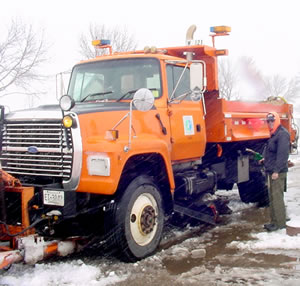 |
Bob Dunne refuels his snowplow before he returns to plowing sections of Hwy 71 and Hwy 9. Dunne is a senior transportation generalist at Willmar. Photo by Dennis Marty
|
No other roads have been closed.
Hernandez also said several vehicles slid into ditches along Interstate 35 in the district since the storm began.
Vehicles sliding off the road, stalls, spin-outs and crashes were numerous in the Twin Cities area, but staff at the Regional Transportation Management Center in Roseville said traffic moved well in spite of them.
“We got an early jump on the storm,” said Mark Fischbach, the Metro District’s snow and ice coordinator. “We started our 12-hour shifts (Tuesday) and that allowed us to get the roads into good shape for the morning commute.”
The Metro District’s efforts resulted in several e-mail messages to the department from commuters whose travels turned out to be better than expected.
Wrote one commuter from the southwestern Twin Cities area: “Kudos to the Twin Cities plow drivers during the winter storm today. All of the roads I traveled this morning were in excellent condition given the weather. My commute, which is normally 30 minutes, only took 40. I was fully expecting an hour or longer.”
By Craig Wilkins
|
back

|
 |
Mn/DOT to deploy new ways of closing roads during snow storms |
 |
 |
A new way of closing roads during snow storms will go into effect in parts of southern and western Minnesota in the near future.
This new system is called Non-Interstate Road Closure Operations. It uses various types of technology to close selected non-interstate roadways in severe weather or in other situations that warrant stopping traffic for a period of time. There are three types of road closure methods in the system: manually lowered gates, remotely controlled signs and manually controlled signs.
There will be 19 manual gates (eight in District 8 and 11 in District 7) on inter-regional corridors, such as Hwy 23 and Hwy 60. The gates will have battery powered signs that are lit when the gates are down. The District 8 gates should be operating some time this winter. The District 7 gates will be installed in time for next year’s snow and ice season.
On lesser traveled roads, motorists will be warned of road closings with remotely activated signs. These sites will be controlled by maintenance staff using a secure Web site and cell phone technology. Mn/DOT will install 26 of these sites, three in District 2, five in District 4 and nine each in District 7 and District 8.
There will also be 53 manual signs—19 in District 7 and 34 in District 8—that will be operated by maintenance staff. These will be located near Mn/DOT truck stations to provide better accessibility and will be installed after the automatic signs are all in place and working.
The closure devices are largely positioned in the southwestern part of the state, where winds can gust to 60 mph and create extremely dangerous travel conditions during a winter storm. The cost of the project will be about $425,000 and the long-range vision for this operation would be to control, activate and track the closures remotely from regional Transportation Operation Communication Centers.
NIRCO is largely a spin-off of what Mn/DOT learned after evaluating closure gates along Interstate 90 in southern Minnesota and I-94 in western Minnesota. Mn/DOT discovered that, on average, roads need to be closed once a year due to blizzard conditions. The barricades are difficult to put in place, particularly during a severe snow storm. Other findings of the studies include:
- Gates provide a clear and indisputable notice that the road is closed
- If roads are closed quickly, fewer crashes occur
- Snow plows clear roads to bare pavement more efficiently when those roads are closed and free of traffic
George Welk, an operations manager in District 7, led the effort on NIRCO before retiring earlier this year. He worked with representatives from the State Patrol and traffic specialists in Mn/DOT Districts 2, 4, 7 and 8. Currently, Bob Williams, District 7, is the project manager.
By Rebecca Arndt and Kevin Gutknecht
|
back

|
 |
New enforcement program reduces travel speeds on Twin Cities, rural roadways |
 |
 |
High travel speed significantly dropped on roads that had speed limits increased from 55 mph to 60 mph, according to data collected by automatic traffic recorders for a seven-day period before and after enhanced enforcement went into effect in October.
Highway Enforcement of Aggressive Traffic, or HEAT, is a year-long $2.5 million federally funded enforcement program, supported by nearly 1,400 hours of additional weekly traffic enforcement by the State Patrol, county sheriffs’ offices and local police departments. The enforcement is complemented by a statewide radio campaign.
Increased enforcement has helped reduce the number of the most egregious speeders, those going over 70 miles per hour, said Bernie Arseneau, director, Office of Traffic, Safety and Operations.
“Reining in that upper tier of speeders reduces the spread of travel speed and produces a safer flow of traffic. We believe continued enforcement will further reduce travel speed disparity,” he said.
In the first two months of HEAT, participating law enforcement agencies statewide stopped nearly 21,000 vehicles and issued a total of 11,098 traffic citations—7,952 for illegal or unsafe speed. In addition, there were 11,536 warnings issued to vehicle operators for speed.
In the Twin Cities metro area, the number of vehicles driving more than 70 mph dropped 25 percent based on data sampling of 4.3 million vehicles on Hwy 100, Interstate 94 and I-35W. In greater Minnesota, data collected on Hwy 2 and Hwy 71 shows the number of vehicles traveling over 70 mph dropped nearly 37 percent.
Mn/DOT officials plan to collect ATR data at more sites and with greater vehicle samples throughout the year.
HEAT is part of the nationally acclaimed Minnesota Comprehensive Highway Safety Plan.
For more information:
|
back

|
 |
Commissioner thanks employees for helping deliver largest construction program in state history |
 |
 |
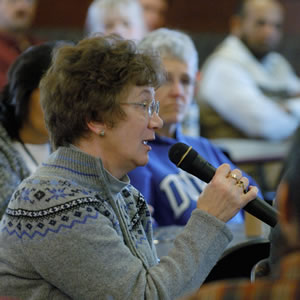 |
|
Jan Ekern, Office of Maintenance, asks a question during the lieutenant governor's address to employees Dec. 8. Photo by David Gonzalez |
More than 250 employees attended Lt. Gov./Commissioner Carol Molnau’s talk in the Central Office cafeteria Dec. 8. After her address, the lieutenant governor answered questions from the audience and from those submitted on the Web in advance of the talk.
"It was good to hear the lieutenant governor speak ‘live,’” said John Cavanaugh, District 1 employee development specialist. “It's rare that those of us outside the Twin Cities area get to hear and see her deliver her remarks."
Molnau thanked employees for doing their part to help deliver the largest construction program in state history in 2005, not only in dollars, but also in number of projects. She also wished everyone happy holidays and said she looks forward to working together in 2006 to improve transportation.
The talk was also broadcast live via streaming video to all Mn/DOT employees on desktop computers and in video conference rooms statewide. However, because of some technical difficulties, some districts and offices could not access the live broadcast.
Employees who did not hear the lieutenant governor’s talk can read notes from her address on the Commissioner’s Web page at http://ihub.dot.state.mn.us/commissioner/.
In addition, responses to the most common questions will be provided on the Commissioner’s Web page by Dec. 30. Responses to other questions submitted with the employee’s name will be sent individually via GroupWise.
For more information, contact Donna Lindberg, Office of Communications, 651/297-8138.
|
back

|
 |
McKenzie to lead Office of Investment Management |
 |
 |
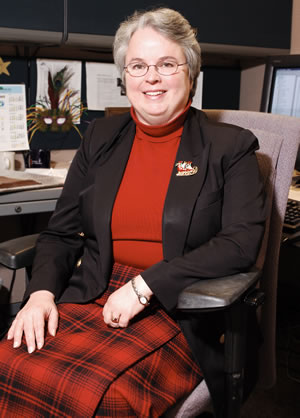 |
|
Abby McKenzie will become the new director of the Office of Investment Management on Jan. 4 when Al Schenkelberg retires. Photo by David Gonzalez |
Abby McKenzie was named as director of the Office of Investment Management. She succeeds Al Schenkelberg, who is retiring.
McKenzie’s appointment becomes effective Jan. 4, 2006.
In her new position, McKenzie will direct department activities that include highway planning and programming, performance measure application and analysis, the annual research program and the annual highway improvement program.
McKenzie currently serves as OIM’s director of statewide planning.
She joined Mn/DOT in 1995 as director of economic analysis. McKenzie was appointed to her current position in 2001.
During her tenure with OIM she led several initiatives including development of the Interregional Corridor system and the 2003 statewide transportation plan.
McKenzie holds a bachelor’s degree in psychology from the University of Iowa and a master’s degree in public policy analysis from the University of Michigan.
Her office will be located on the third floor of the Transportation Building; telephone number will remain 651/296-6194.
|
back

|
 |
Barnes begins one-year assignment with Office of Enterprise Technology |
 |
 |
 |
|
Mike Barnes, left, has taken a one-year position on the management team of the state’s Office of Enterprise Technology. Mjyke Nelson will serve as director of Mn/DOT's Office of Information Technology during Barnes' absence. Photo by David Gonzalez |
Mike Barnes, director of the Office of Information Technology, now serves on the management team of the state’s Office of Enterprise Technology.
His one-year assignment began Dec. 5.
Barnes’ responsibilities include assisting the office identify and carry out new shared information technology services.
The office was created earlier this year as part of the state’s Drive to Excellence Program.
During Barnes’ assignment, Mjykhael Nelson will serve as director of OIT. Bill Roen will fill in for Nelson as supervisor of the office’s Program Management Section. Their phone numbers and office locations remain the same.
Barnes, who was appointed OIT director in 2003, also served as Mn/DOT’s lead representative with the Drive to Excellence Program from August 2004 to April 2005.
A Hutchinson native, Barnes holds a bachelor’s degree in civil engineering from the University of Minnesota.
Barnes may be reached at 651/556-8027 and by e-mail.
|
back

|
 |
State agencies asked to reduce energy consumption by 10 percent |
 |
 |
Rising energy costs for electric power, natural gas and heating fuel, among other factors, have prompted the governor to require that all state agencies reduce energy use by 10 percent in state-owned buildings during the next calendar year.
Executive Order 05-16, for example, requires all state agencies to set maximum heating temperatures at 68° F to 70° F for all occupied areas and cafeterias (lowered to 60° F to 62° F during non-working hours) and 55° F for all unoccupied spaces. During the summer, cooling temperatures will be set at 76° F to 78° F for all occupied space; temperatures settings for air-conditioning should be turned off or raised to 85° F during nights and weekends.
Computer rooms, research facilities and special care facilities are exempted from these requirements.
In the wake of the governor’s announcement, many Mn/DOT employees have asked whether they also should turn off their computers when not in use in order to save energy.
According to the Office of Information Technology, the answer is "no."
Employees should continue to log-off, shut down and restart their computers at the end of the work day to allow important security measures and updates to be performed.
However, users should turn off the monitor (computer screen) of their computer at the end of the work day, over weekends, holidays and other extended periods away from their work station. It is estimated that monitors consume 75 percent of total computer energy use.
For more information, contact Linda Dahlen, Office of Information Technology, 651/297-7196.
|
back

|
 |
Air shuttle schedule changes |
 |
 |
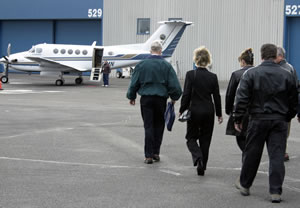 |
|
Shuttle passengers walk out to the Beechcraft KingAir at Holman Field in St. Paul. Photo by Dan McDowell |
Users of the Mn/DOT air shuttle transportation system will see two schedule changes in 2006.
Effective Jan. 1, the Duluth/Eveleth shuttle will be cancelled, and the Bemidji/Detroit Lakes shuttle schedule will change from flights every other week on Tuesday and Thursday to flights every Tuesday only.
The shuttle, a Beechcraft KingAir aircraft that seats eight passengers, is available to other state agencies on a space available basis. It departs from Million Air (formerly Regent Aviation) at the St. Paul Downtown Airport (Holman Field) at 7 a.m. and returns at approximately 5:15 p.m.
Flights to other destinations can be scheduled by contacting Vee Dellwo or Barb Lovness at 651/296-6666 and completing an air travel request form.
Click here to view the shuttle schedule on the iHUB: http://ihub.aero/aircraftshuttle.html.
|
back

|
 |
Hurricanes lower grain shipping rates by river for 2005 |
 |
 |
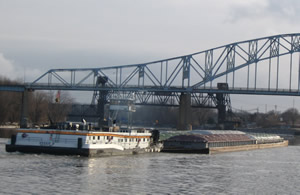 |
|
The towboat M/V Reggie G leaves Lock and Dam No. 2 in Hastings on the last day of the shipping season pushing six barges loaded with grain. Photo by Dick Lambert |
The reach of hurricanes Katrina and Rita extended as far north as Minnesota and hampered grain shipment on the Mississippi and Minnesota rivers during the 2005 shipping season.
Dick Lambert, director of the Ports and Waterways Section, said grain shipping tonnage dropped by about 10 percent compared with last year.
Early reports, he said, show grain shipments dropped from 5 million tons in 2004 to about 4.5 million tons this year.
While the state recorded bumper crops of corn and soybeans, the devastation caused by the massive storms caused delays of three weeks or more for downriver shipments.
Lambert said the storms damaged port facilities in the Gulf Region and sidelined about 400 barges used to ship grain. About 100 barges were damaged or washed up on shore. More than 300 barges were out of service until their rain-soaked grain cargoes were removed.
Much of this year’s grain harvest, he said, will be kept in storage and shipped by truck, rail or by river next year.
This year’s shipping season lasted seven days fewer than last year, he said, further limiting shipment of grain and other commodities.
Grain accounts for about 80 percent of the commodities shipped from Minnesota by river. River ports are located in Minneapolis, St. Paul, Savage, Red Wing and Winona.
Barge receipts for shipments of sand and gravel, fertilizers, cement and coal upriver into Minnesota stayed at the 2004 level of about 6 million to 7 million tons, Lambert said.
Minnesota’s river shipping season ended officially on Nov. 30 when three towboats left St. Paul pushing barges loaded with grain and petroleum.
By Craig Wilkins
|
back

|
 |
|
 |



